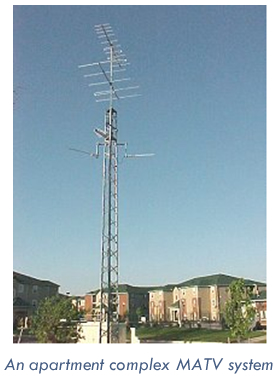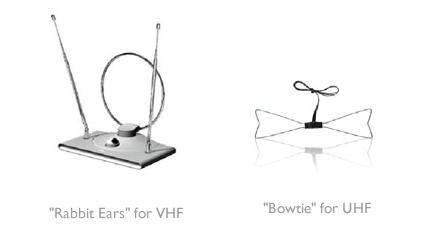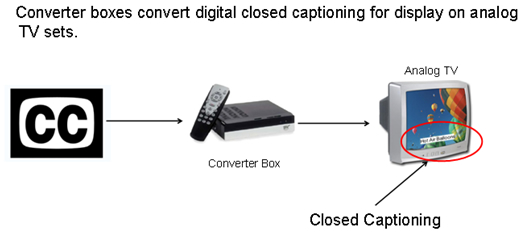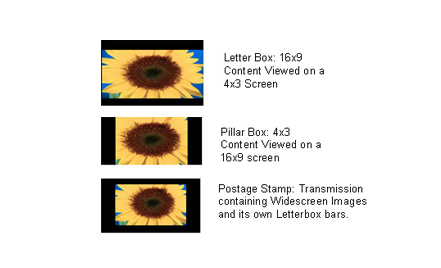Learn About DTV
Frequently Asked Questions
Please note that the June 12, 2009 DTV transition deadline does not apply to low-power television (LPTV) stations. The FCC will determine a deadline for these stations to transition to digital at a future date. Learn more about LPTV.
- Digital Transition
- Your Television
- Cable and Satellite
- Converter Box
- General Questions
- Top FAQs
General Questions
- Will Emergency Alerts and Broadcasts Continue with DTV?
- Do I Need a Special Antenna to Receive DTV Signals?
- What about Parental Control with DTV (V-Chip)?
- What Is the Difference Between a Master Antenna (MATV) vs.Cable vs.Satellite?
- Can I Use My UHF/VHF Antenna to Receive DTV?
- Does DTV Support Closed Captioning?
- Will DTV Provide Emergency Video Descriptions?
- What Are Low Power TV (LPTV) Stations?
- What Are My Reception Options with Low Power TV (LPTV)?
- What Is Screen Cropping? Why Are There Black Bars Around My Picture?
- How Do I Improve Picture Quality?
- Can I Connect My Portable TV Set to a Digital-to-Analog Converter Box?
- What about Mexican/Canadian Broadcasts?
- What about TV Rebroadcasts of AM/FM Radio?
- Will Radio Be Available on Analog TV?
- How Do I Connect the Antenna?
- Why Have I Lost Channels?
- I Don’t Have a Picture. What Should I Do?
- Help! I have Multiple Technical Issues!
Will Emergency Alerts and Broadcasts Continue with DTV?
Yes. DTV stations are required to continue operating the Emergency Alert System (EAS).
Do I Need a Special Antenna to Receive DTV Signals?
No. DTV signals do not require a special antenna. The reception of over-the-air DTV programming requires the same type of signal reception equipment (an antenna) that worked with your analog TV set.
If you needed a rooftop antenna to receive analog TV broadcasts, the same antenna generally will work to receive DTV broadcasts. It should not be necessary to purchase new antennas that are marketed “digital ready” or “HD ready.”
While you do not need a special antenna to receive DTV signals, you will need additional equipment to receive over-the-air television when the DTV Transition is completed -- if you use an analog TV set that has only an analog tuner.
Consumers who rely on antennas (including outdoor antennas and "rabbit ears") to receive over-the-air broadcast signals on analog sets with analog tuners will need to obtain separate digital-to-analog set-top converter boxes to watch over-the-air TV.
These boxes receive digital signals and convert them into analog format for display on analog sets. Analog sets connected to such converter boxes will display digital broadcasts, but not necessarily in the full, original digital quality.
For more information on antennas, see the Antenna Guide.
What about Parental Control with DTV (V-Chip)?
FCC rules require that V-chip logic be built into digital TV sets and other DTV reception devices, just as they were in analog TV sets. You can learn about the ratings system, also known as “TV Parental Guidelines,” at www.fcc.gov/vchip.
The V-chip is a technology that enables parents to block television programming based on a program’s rating. The ratings are encoded within the television signal. The V-chip reads the encoded rating information of each program and blocks shows according to the parents’ blocking selections.
What Is the Difference Between a Master Antenna (MATV) vs.Cable vs.Satellite?
Check with your landlord, building manager, homeowner, condo association or video provider to find out what type of input signal (broadcast or cable) your Master Antenna (MATV) system is using and how you are affected.
If you subscribe to the cable TV service offered in your city or town, or if you subscribe individually to satellite TV service and receive your local channels through your own satellite dish, you will continue to receive your local broadcast channels without having to buy a digital TV set or DTV converter box.

For more information on antennas, see the Antenna Guide.
Can I Use My UHF/VHF Antenna to Receive DTV?
Television stations broadcasting in digital use both the VHF (channels 2-13) and UHF (channels 14-51) bands. Many indoor antennas use “rabbit ears” for the VHF band and a “loop” or “bow-tie” antenna for the UHF band.
Make sure you are using an antenna that covers both the VHF and UHF bands and have connected it properly.

For more information on antennas, see the Antenna Guide.
Does DTV Support Closed Captioning?
Yes. FCC rules require that digital-to-analog converter boxes be able to convert over-the-air digital Closed Captioning for display on analog TV sets.

Will DTV Provide Emergency Video Descriptions?
FCC rules state that broadcasters must orally describe any emergency information that is shown on the screen. With DTV, broadcasters have more audio channels on which to provide the video description.
Emergency information that is not orally described must be accompanied by an aural tone which instructs individuals with vision disabilities to turn to a radio or another source for more information.
Contact your local broadcasters to determine whether video description is offered.
Video descriptions are a way to inform people who are blind or have other vision disabilities of what is happening on the television screen. Video description is the insertion of verbal descriptions about the setting and/or action in a program when information about these visual elements is not contained in the audio portion of the program. These descriptions supplement the regular audio track of the program.
What Are Low Power TV (LPTV) Stations?
Low Power TV (LPTV) stations are usually smaller, community-owned and operated stations, or stations broadcasting in foreign languages.
LPTV stations can also be translator or booster stations that extend a television station's signal to areas not reached by the main transmitter. The mandatory DTV Transition deadline does not apply to these LPTV stations.
What Are My Reception Options with Low Power TV (LPTV)?
LPTV stations are not affected by the DTV Transition. Switching to digital specifically for LPTV broadcasts only is not required. There are several options. Follow up with your LPTV broadcaster.
Here are your choices:
- Keep an analog TV connected to a broadcast antenna to view analog LPTV and translator station broadcasts.
- Purchase and use a digital-to-analog converter box that has analog pass-through capability. Analog pass-through allows you to watch analog TV broadcasts as well as digital TV broadcasts through the converter box.
- Purchase and use a digital-to-analog converter box without analog pass-through capability, and then connect a "splitter" or antenna switch to receive both analog and digital broadcasts. Check with your consumer electronics retailer if you need instructions on how to connect the box to view broadcasts from both analog and digital stations.
- Purchase a digital television set with a built-in digital tuner that can receive both analog and digital stations.
- Subscribe to a cable television or other pay service that carries the analog station(s) you want. .
To check for the DTV signals that are available at your location, use the DTV Reception Maps available in FCC’s Support Center.
What Is Screen Cropping? Why Are There Black Bars Around My Picture?
To properly display digital content, bars may be placed at the top, bottom, and/or sides of the image to ensure that the image is not distorted.
Some digital-to-analog converter boxes and digital TV sets also provide the ability to alter the image to fit the screen, either by “stretching” or “squeezing” the image. Please consult the owner’s manual of your digital TV set or digital-to-analog converter box for details on how to eliminate the bars through zooming, stretching or squeezing the image on your screen.

How Do I Improve Picture Quality?
On a higher-resolution TV set (HDTV), a lower-resolution channel or program will appear in lower resolution. Switching between a high-resolution and a low-resolution program or channel will result in a visible loss of image quality.
To check for the DTV signals that are available at your location, use the DTV Reception Maps available in FCC’s Support Center.
For more information on antennas, see the Antenna Guide.
Can I Connect My Portable TV Set to a Digital-to-Analog Converter Box?
If you want to connect a portable, battery-powered analog TV set to a digital-to-analog converter box, it must have an “Antenna In” port in order to connect the converter box. The box must have a local utility power source or an alternative power source.
Another option for consumers is to obtain a battery-powered digital television. Battery-powered digital televisions are marked with words such as “Integrated Digital Tuner,” “Digital Tuner Built-in,” “Digital Receiver,” “DTV,” “ATSC” or “HDTV.” Check with your local electronics stores or online retailers for product availability.

What about Mexican/Canadian Broadcasts?
Canadian TV stations will transition from analog to digital broadcasting, but not until August of 2011. Mexico has begun its transition and will complete it in 2021.
If you have an analog-only television that receives free over-the-air programming with an antenna, you will need to purchase a digital-to-analog converter box with "analog pass-through" capability in order to continue watching both analog and digital broadcasts .
What about TV Rebroadcasts of AM/FM Radio?
To listen to any rebroadcasted audio on an analog TV, you will need a digital-to-analog converter box.
Will Radio Be Available on Analog TV?
The radio on a radio/analog TV combination unit will continue to function if the TV is connected to a digital-to-analog converter box containing an analog pass-through feature.
You should check with the converter box manufacturer to be sure. The NTIA maintains a list of analog-pass-through-capable boxes at www.ntiadtv.gov/cecb_list.cfm ![]() .
.
Specific connection information for an antenna depends on the type of device and its configuration. The antenna manufacturer should provide detailed connection instructions.
For more information on antennas, see the Antenna Guide.
Your DTV reception can be affected by terrain, trees, buildings, the weather, damaged equipment, as well as antenna type, location, and orientation. It can be improved just by changing the location of the antenna you’re using now.
Moving your antenna away from other objects and structures, or placing it higher, can often improve reception. The performance of outdoor antennas can degrade over time due to exposure to the weather. Also, you may consider installing a signal booster, which should improve reception.
If you are having trouble receiving a broadcast:
- Check your connections.
- Perform a channel scan.
- Adjust your antenna.
The FCC Consumer Facts sheet “Troubleshooting Guide For Digital-to-Analog Converter Boxes and Digital Televisions” at http://www.fcc.gov/cgb/consumerfacts/troubleshootguide.html should help you diagnosis and correct your problem.
To check for the DTV signals that are available at your location, use the DTV Reception Maps available in FCC’s Support Center.
If you are still experiencing difficulties, go to the FCC Support Center.
I Don’t Have a Picture. What Should I Do?
Your DTV reception can be affected by terrain, trees, buildings, the weather, damaged equipment, as well as antenna type, location, and orientation. It can be improved just by changing the location of the antenna you’re using now.
Moving your antenna away from other objects and structures, or placing it higher, can often improve reception. The performance of outdoor antennas can degrade over time due to exposure to the weather. Also, you may consider installing a signal booster, which should improve reception.
If you are having trouble receiving a broadcast:
- Check your connections.
- Perform a channel scan.
- Adjust your antenna.
The FCC Consumer Facts sheet “Troubleshooting Guide For Digital-to-Analog Converter Boxes and Digital Televisions” at http://www.fcc.gov/cgb/consumerfacts/troubleshootguide.html should help you diagnosis and correct your problem.
To check for the DTV signals that are available at your location, use the DTV Reception Maps available in FCC’s Support Center.
If you are still experiencing difficulties, go to the FCC Support Center.
Help! I have Multiple Technical Issues!
Your DTV reception can be affected by terrain, trees, buildings, the weather, damaged equipment, as well as antenna type, location, and orientation. It can be improved just by changing the location of the antenna you’re using now.
Moving your antenna away from other objects and structures, or placing it higher, can often improve reception. The performance of outdoor antennas can degrade over time due to exposure to the weather. Also, you may consider installing a signal booster, which should improve reception.
If you are having trouble receiving a broadcast:
- Check your connections.
- Perform a channel scan.
- Adjust your antenna.
The FCC Consumer Facts sheet “Troubleshooting Guide For Digital-to-Analog Converter Boxes and Digital Televisions” at http://www.fcc.gov/cgb/consumerfacts/troubleshootguide.html should help you diagnosis and correct your problem.
To check for the DTV signals that are available at your location, use the DTV Reception Maps available in FCC’s Support Center.
If you are still experiencing difficulties, go to the FCC Support Center.

